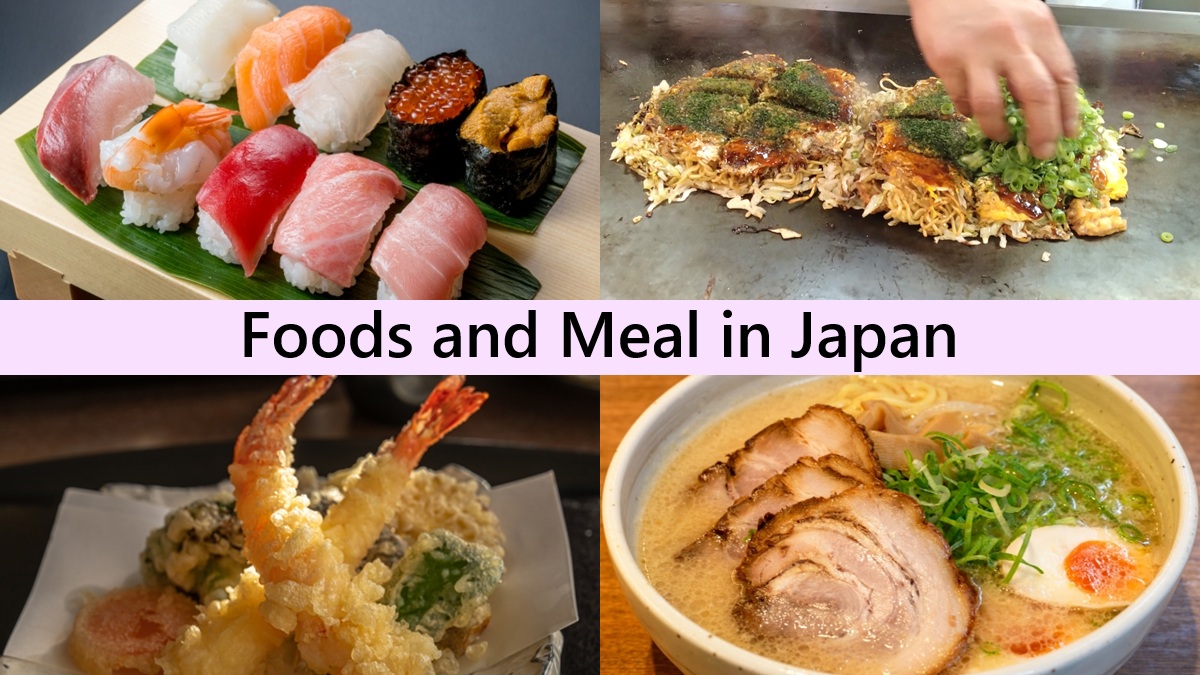Foods and Meal in Japan
What is Japanese cuisine? Basic Japanese meal Popular menu of Japanese foods Japanese confections Japanese tea Japanese alcoholic drink Restaurants in Japan
What is Japanese cuisine?
Characteristics Japanese Taste Cooking methods Main Ingredients
Characteristics of Japanese cuisine
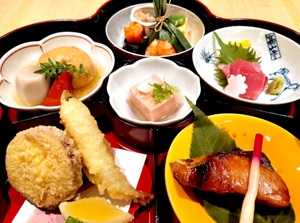
Traditional Japanese cuisine has the following features.
- Little oil is used. Fried dish was introduced from overseas.
- Dairy products such as butter, milk are not used.
- Spice is used a little for accent of taste, so it doesn't dominate the taste.
- Main ingredients are fish and vegetables, but meats are secondary.
- Fresh raw food dish is one of the cuisine.
- Cold dish is one of the cuisine.
- The staple is rice.
Of course, some modern Japanese dishes created with the elements of Chinese and Western cuisines are also established in Japanese people.
Taste of Japanese cuisine
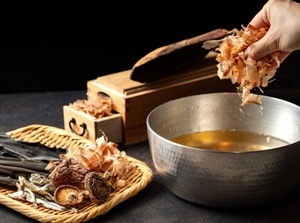
Making Dashi is important in Japanese cuisine
Dashi is the soup stock used in Japanese cuisine.
It is made from shaved dried bonito fish, kelp called konbu, dried shiitake mushroom, etc.
So, the taste is very light and delicate fish soup, but it is never fishy.
After that, Shoyu (soy souse), Miso (paste of fermenting soybeans), Mirin (rice wine for cooking), Sugar are mixed to Dashi in specific proportions according to the dish.
By Mirin and Sugar, the taste of the soup is a little salty-sweet with above flavors.
Most Japanese dishes are made using above mixed soup.
As the spices for Japanese dishes, Wasabi, Ginger, Dried red pepper, etc. are used just a little.
Wasabi is indispensable spice to Sushi and Sashimi, and it is mostly planted only in Japan. So, you will taste real wasabi when you visit Japan.
Cooking methods of Japanese cuisine
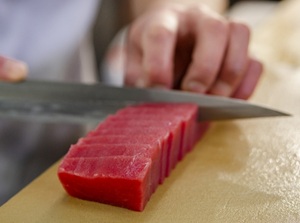
Making sashimi of tuna
Main cooking methods of Japanese cuisine are simmering, grilling and steaming.
But, serving raw foods is for Japanese chefs to show their skills.
They cut them skillfully, and make an artistic and delicious-looking dish.
So, Sushi and Sashimi are the stars of Japanese cuisine.
Frying in oil was introduced from China and Western countries in the modern era.
Tenpura and Tonkatsu (Japanese pork cutlet) are popular Japanese dishes, but they are the recent dishes from the 19th century.
Ingredients for Japanese cuisine
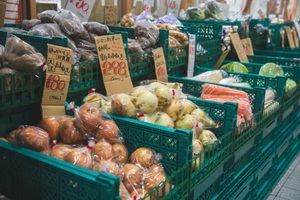
Vegetables in a market
Various vegetables and fruits are used for Japanese cuisine.
Probably, there are some ingredients which are not in your country.
There are also some seasonal ingredients, so Japanese people can feel the change of the seasons by eating the dishes using such ingredients.
Some seaweeds such as nori and konbu are important ingredients in Japan.
Nori is an important supporting food of Sushi, and konbu is used to make Dashi stock.
And, edible wild plants are used for the dishes in the mountain.
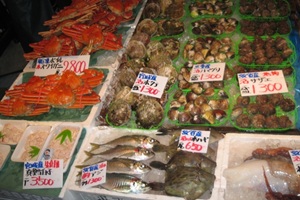
Fishes in a market
Fishes are the main ingredients for Japanese cuisine.
Japanese people differentiate many fishes, and the name of each fish is used for the name of its dish.
Apart from that, squid, octopus, shrimp, prawn, crab, shellfish, etc., various other sea foods are also eaten.
Fishes are cooked in various ways, but fresh raw fishes are the best foods for Japanese people.
On the other hand, meats such as beef, pork, chicken have been eaten since the 19th century in Japan.
Some popular Japanese dishes using the meats have already known in the world.
But, Japanese people basically don't eat raw meats.
Egg is used as an ingredient in the world.
In Japanese cuisine, egg is often used.
In a few dishes, raw egg is eaten like a tasty sauce.
The foreign visitors are surprised at that, but Japanese people like that.
Eggs in Japan are shipped after cleaning and sterilizing of eggshell.
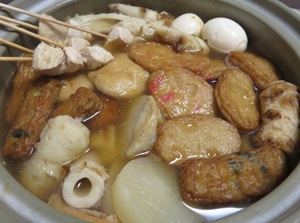
Oden stew using many fish processed foods
Some Processed foods are used as ingredients of the dishes.
Tofu is a well-known processed food, and it is made from soy beans.
And there are some processed food made of Tofu.
Fishes are main ingredients, and various processed foods are also made from fishes.
Kamaboko, Chikuwa, Hanpen, Satsuma-age, etc., the products with various forms and tastes are made.
And, there are a few processed foods using unique ingredients in only Japan.
Basic Japanese meal
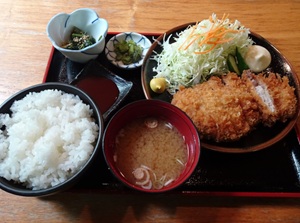
Set meal of Tonkatsu
Japanese meal basically consists of main dish, rice, soup.
A side dish and pickles are sometimes added.
In most cases, these are served at the same time as a set.
There is no rule of the order that you eat the dishes.
Eating rice is the main aim of Japanese meal.
So, the other dishes are the supporting roles to eat rice deliciously.
Rice & Bread Main dish of Japanese foods Japanese soup Japanese pickles
Rice and Bread
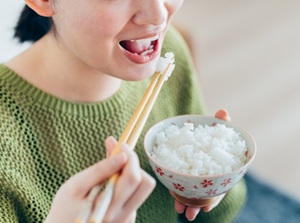
How to eat rice in Japan
Rice is the staple food of Japanese people.
This is indispensable for Japanese meal.
It is basically eaten in the style of simple boiled rice, but there are various rice dishes with other cooked foods and tastes.
Bread is sometimes eaten as light breakfast or lunch instead of rice, and it is also eaten as snack.
Various types of bread are sold in Japan, and they are also popular among the foreign tourists.
Mochi is a cake made of rice.
It is mainly eaten as a special staple in new Year's day, and is also used for an ingredient of Japanese confectionery.
Main dish of Japanese foods
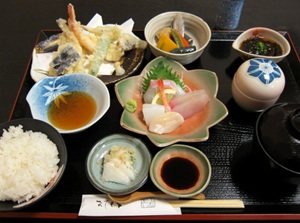
Set meal of Tenpura and Sashimi
Main dish is the attractive dish in Japanese meal.
Naturally, fish or meat is used as the main dish.
As raw dish, Sashimi of fishes is the top of Japanese cuisine.
As simmered dish, simmered fish is tasty, and meats are mainly simmered with vegitables.
The soup stock to simmer is above dashi and Japanese seasonings.
As grilled dish, fish or meat grilled directly on the fire is main.
It is cooked in the kitchen in the restaurant, but a cooking device called roaster is used at home.
As frying dishes, Tenpura and Tonkatsu are well-known.
Both dishes are cooked at home, and there are many restaurants specializing in them.
These dished are introduced in the following page in detail.
Japanese soup

How to 'drink' Miso-soup
Miso-soup is the representative Japanese soup.
Miso paste is mixed in Dashi stock and a few ingredients are put into the soup.
Miso-soup is basically served with rice, so it is essential for Japanese meal.
Western people say "eat soup", but we say "drink soup" for Miso-soup.
It is the normal eating that we drink Miso-soup from the bowl directly.
(The ingredients in the bowl are eaten using chopsticks.)
Suimono is the soup without miso.
High quality Dashi stock is used and the soup is clear.
Suimono is mainly served in high-class meal instead of Miso-soup.
Japanese pickles
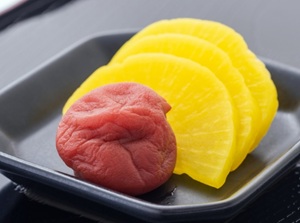
Umeboshi and pickles of Daikon
Japanese pickles are very simple and vegetables are pickled with salt, vinegar, etc. without spices having strong fragrance.
It is a small side dish as a palate refresher in the meal.
Daikon (Japanese white radish), turnip, hakusai (Chinese cabbage), eggplant, cucumber, etc. are used for the pickles.
Umeboshi shaped in the form of small red ball is often served with rice.
It is a pickled fruit of Japanese apricot, and is very salty and sour.
Foreigners may dislike it.
Popular menu of Japanese foods
Sushi Donburi dish Noodles Flour-based Snack One-pot dish Okinawan dishes Japanized foreign dishes Bento, Ekiben
Sushi
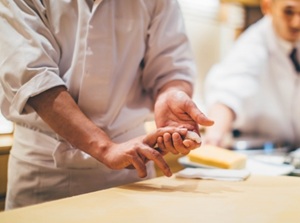
Making sushi by hand
Sushi is the most popular Japanese food among foreign tourists.
Sushi chef combines vinegared rice with a slice of fresh raw fish by hand.
So, after the order from customer, the chef can serve it within a few minutes.
That is just fast food.
The sushi of such style is called "Edomae-zushi".
It means "Sushi using fishes from the sea in front of Edo (current Tokyo)".
It has developed in Tokyo since the early 19th century.
The style spread throughout Japan and it became the standard style of sushi.
It is difficult for ordinary Japanese people to make real Edomae-zushi, because sushi chef needs deep knowledge about fresh foods and special cooking skills.
So, we visit sushi restaurant and enjoy the special meal of sushi.
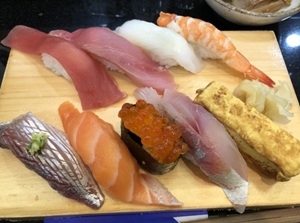
A set of Edomae-zushi in a sushi bar
Sushi restaurant is also translated as Sushi bar.
There are counter seats, and the chefs cook in front of the customers.
Skilled sushi chefs use selected fresh ingredients and make tasty sushi.
So, the price is relatively expensive.
By the way, there is no menu in most sushi bars and the names of purchased fishes are simply posted up.
You need to enjoy tasting sushi without worrying about the price.
So, after the meal, you can know the total price for the first time.
Kaiten-zushi (Conveyor belt sushi restaurant) is popular and casual and the price is cheap.
All prices are displayed in the menu.
For many customers, a large quantity of standardized sushi are made using robots one after another.
There may be sushi restaurants in your country.
If you have eaten the sushi there before, you should taste original sushi in Japan.
Recently, Onigiri is popular for foreign tourists, but, Onigiri
is different from Sushi.
Sushi uses vinegared rice and raw fish, but Onigiri is simply a rice ball using ordinary boiled rice without vinegar.
Sushi is a special Japanese dish, but Onigiri is a homemade and portable lunch.
Donburi dishes
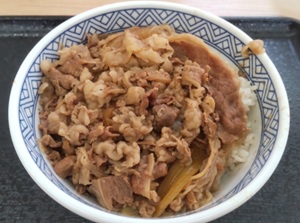
Gyudon in a restaurant chain
Donburi means ceramic bowl and is twice as large as the small bowl to eat rice.
Boiled rice is put in the Donburi and cooked food is topped on the rice.
It is a fast food that main dish and rice have been combined and we can eat both foods at once.
There are some popular Donburi dish, and "Don" in the word of "Donburi" is added for the name of the dish.
Gyudon is the dish that cooked sliced beef and onion are topped on the rice, and the taste is like Sukiyaki.
Tendon is the dish that a few kinds of Tenpura are topped on the rice.
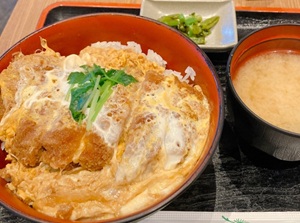
A set of Katsudon
Katsudon is the dish that a tonkatsu is topped on the rice with cooked onion and egg.
These dishes are mainly served in most cheap restaurants because busy people want to eat lunch quickly.
And there are a few restaurant chains for each Donburi dish.
Unadon is the dish that broiled eel is toppped on the rice, and it is eaten in the restaurant specializing in eel dish.
Kaisendon is the dish that Sashimi of some kinds of fish are topped on the rice, and is eaten as a lunch menu in Sushi restaurant, etc.
Noodles
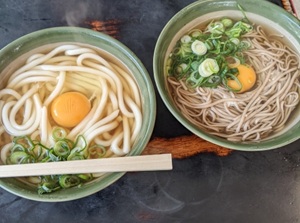
Udon and Soba topped with raw egg
There are two types of Japanese noodle which have been eaten instead of rice from ancient times.
Udon is a noodle made from wheat.
It is thicker and softer than spaghetti.
Soba is a noodle made from buckwheat.
The noodle is thin and having the color of light brown.
They are boiled and are put in a bowl with hot Japanese soup broth.
There are various kinds of dishes by topping a few foods.
In hot season, cooled Soba and Udon are popular.
Cold Japanese soup broth is served in a small bowl, and we eat the cold noodles dipping in the soup.
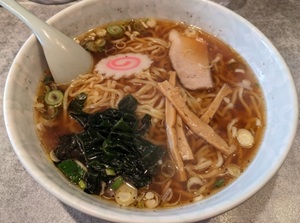
Soy sauce ramen
Ramen is a noodle dish using yellow Chinese noodle.
In the late 19th century, Chinese dishes were introduced by Chinese people living in Japan, and Chinese cuisine spread in Japan.
In the 1910s, a Japanese chef in Asakusa in Tokyo served a Chinese noodle dish adding Japanese taste.
It was the first Ramen, and his restaurant became popular in Japan.
Hot soup broth taken from pork and chicken bones are poured into a bowl, and Japanese taste of soy sauce or Miso is added.
Boiled Chinese noodle is put into the soup, and sliced Chinese-style pork and Chinese bamboo shoots, etc. are topped on the noodle.
Ramen restaurant is generally small and narrow and counter seats are main.
And the chef serve the ramen with own taste.
Flour-based Snack
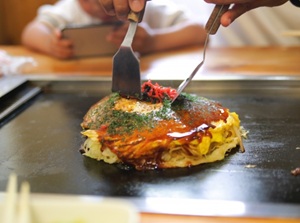
Making Okonomiyaki on the hot plate
Okonomoyaki is Japanese pancake using flour.
It is mainly cooked on the hot iron plate in front of the customers.
So, Okonomiyaki is a snack that the customers can enjoy the process of the cooking.
The batter mixed with flour, egg, chopped cabbages is grilled like a pancake on the plate.
Sliced pork, squid, shrimp, etc. are put under the batter in response to a customer's request.
Special Worcestershire sauce is spread over the grilled pancake and green lavers are sprinkled.
This is Kansai-style Okonomiyaki, and many restaurants are in Osaka.
Another popular Okonomiyaki city is Hiroshima.
In Hiroshima, fried Udon or Chinese noodle are put under thin pancake, and thick and salty-sweet Worcestershire sauce is used.
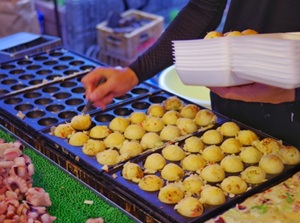
Making Takoyaki in a stand
Takoyaki is the food with the shape and size like table tennis ball.
The batter similar to Okonomiyaki is poured into many hemispherical molds on the iron plate.
Tako means octopus, so a small piece of octopus is put into the batter in each mold.
And each Takoyaki is broiled like a ball.
The inside of Takoyaki is very hot and creamy.
Takoyaki was born in Osaka.
In Osaka city, you can find many stands selling takoyaki and eat it as a snack on the street.
One-pot dish
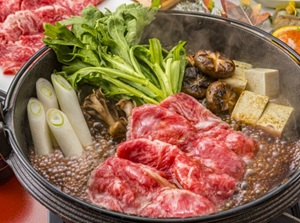
Making Sukiyaki
A portable stove is set on the center of a table and a pot is put on it.
A few members of family or friends sit around the pot.
Various foods and soup are put in the pot and are stewed.
Each member eat the foods picking up from the pot.
This is called one-pot dish.
In Japanese, it is called Nabemono or shortly Nabe.
Especially, Nabemono is popular in the cold season.
The scene is like a small party for eating.
Most expensive dish is Sukiyaki.
Sliced tasty beef is main and tofu and various vegetables are stewed in the soup with soy sauce and sugar at the same time.
The cooking style of Nabemono is simple, so various Nabemono dishes are made by combination of ingredients.
Okinawan dishes
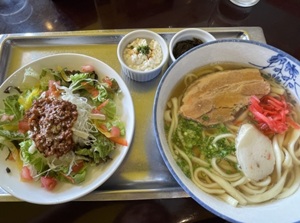
Popular Okinawan dishes, Taco Rice & Okinawa Soba
Okinawa is the islands to the southwest of the mainland of Japan, and the islands are surrounded by the subtropical ocean.
Okinawa was a kingdom named Ryukyu until the early 17th century, so it has a unique culture different from the mainland of Japan.
Okinawan cuisine has also a unique dishes.
From the geographical location, the history and the climate, the cuisine is similar to the Chinese dishes in Taiwan and the southern China.
Whole parts of pig are the important ingredients, and tofu made in Okinawa is often used.
Konbu is an important seaweed for Japanese cuisine and is gathered only in the northern sea around Hokkaido island.
But, by the trade with China in Ryukyu period, Konbu had been known and treated in Okinawa.
So, Konbu is also an important ingredient in Okinawa cuisine.
Japanized foreign dishes

Gyoza
There are some foreign dishes which were introduced to Japan and became popular.
Of course, they have been changed to the style for Japanese meal.
Chinese cuisine has suited Japanese palate since for a long time.
Ramen is the most popular Japanized Chinese dish.
Gyoza is also one of such dishes.
A lump of minced pork and chopped vegetables is wrapped with a thin dough and is mainly fried on a pan.
It is a popular side dish of ramen or rice.
In China, it is called "Jiaozi" and is mainly one of staple foods.
And it is eaten after boiling in hot water.
That is the difference from Japan.
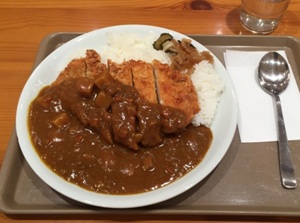
Katsu Curry (Curry rice topped with Tonkatsu)
Curry is the Japanese people's favorite Western dish.
Of course, curry is Indian dish.
But Englishmen brought this from colonial India into Japan in the late 19th century, so Japanese people had recognized curry as Western dish.
Japanese people applied curry to eating rice with a Western taste.
That is Curry Rice.
Even Japanese people eat curry rice not with chopsticks but with a spoon.
There are some other Japanized foreign dishes.
Bento, Ekiben
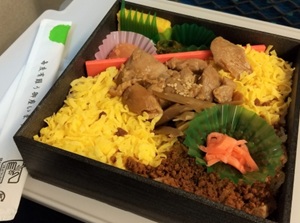
Eating an Ekiben in Shinkansen train
Bento means a box lunch.
It is basically a homemade lunch to eat at a place of visit.
Rice and side dishes are packed in a lunch box.
Various Bento are also sold for takeout in many shops before noon.
They also are one of Japanese meals.
Especially, Bento selling in railway station is called Ekiben.
"Eki" means railway station and "ben" is from "Bento".
The long-distance trains in Japan have no dining car.
So, when you must stay in the train at mealtime, you can eat the Ekiben which you bought at the terminal station on the seat in the train.
So, in most terminal stations, many kinds of attractive Ekiben are sold and some of them use the foods with regional characteristics.
Japanese confections
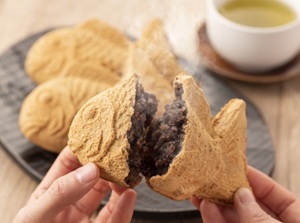
Taiyaki containing sweet 'an'
In Japan, various candies, chocolates, cakes, etc, western-type of confectionaries are sold in the shops throughout Japan.
On the other hand, traditional Japanese confections have also been eaten since old times.
Rice flour, wheat flour and sugar are mainly used as the ingredients.
Milk and butter are basically not used.
Instead of cream and jam, sweet "an" (or "anko") is used as the filling for Japanese confections.
It is the paste made from red beans and sugar, and it is the main taste of Japanese sweets.
There are various types from cheap and simple confection to artistic and expensive confection for ceremony.
Japanese tea
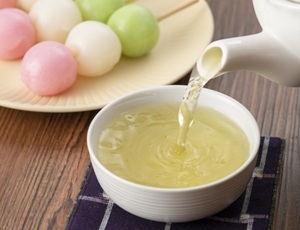
Japanese sweets and green tea
Green tea is the main tea drunk in Japan.
The color is light green or yellow.
Some kinds of tea have brown color.
The leaves of black tea are produced by fermenting, but the leaves of green tea are produced without fermenting.
So, the tastes are a little different from each other.
In addition, sugar is often added to black tea, but it is never added to Japanese green tea.
Green tea is served in home, Japanese restaurants, etc.
And, in the cafe serving Japanese confections, green tea is the main drink.
Now, green tea as refreshing beverage contained in plastic bottle are sold in vending machine, convenient store, supermarket. etc.
You can drink it easily, when you travel around Japan.
There is "tea ceremony" as a traditional Japanese culture.
In the ceremony, special tea named "maccha" is used.
It is the tea powder made from high-class leaves of green tea, and the tea is made by stiring maccha and hot water in a bowl.
Japanese alcoholic drink
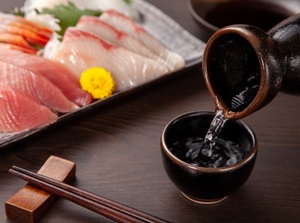
Enjoy eating sashimi while drinking Sake
Beer, whisky, wine, sake, shochu are mainly drunk as alcoholic beverages in Japan.
And various liqueurs are popular as cocktail or with soda water.
Sake is the Japanese traditional alcoholic beverage.
It is clear and colorless, but it has fruity aroma.
And, it has a little higher alcohol content than wine.
Both warmed sake and cold water are OK as the method of drinking.
Sake is translated as "Rice wine" in English.
Like the words suggests, Sake is made from rice and tasty water.
Sake breweries are dotted in many local areas in Japan.
The sake of each brewery has a brand name with a few kanji characters (Chinese character).
In the southern Kyushu island, the climate is too warm for sake brewing.
So, Shochu is mainly brewed.
Shochu is a distilled alcohol, and is made from rice, barley, buckwheat or sweet potato.
In Okinawa islands, Awamori is brewed as a distilled alcohol.
It is made from Indica rice which is planted in the tropical areas, so the taste is different from Shochu.
Restaurants in Japan
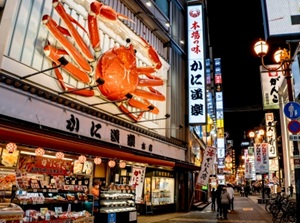
Popular street of restaurants, Dotonbori in Osaka
There are many restaurants serving a specific kind of the dish.
For example, sushi, ramen, tonkatsu, Japanese noodles, etc. are eaten in each restaurant for the dish.
You visit a restaurant that you want to eat a dish in above dishes.
Many Japanese restaurants set up counter seats.
The chefs show the cooking works and skills and can make conversation freely with the customers across the counter.
The reataurants are generally opened from around 11:00 to around 14:00 for lunch, and from around 17:00 in the evening.
Izakaya is Japanese pub, but it may be a kind of restaurant that you can eat various Japanese dishes.
It is mainly opened from around 17:00 to around 23:00.
Credit card is used in major restaurants, but the payment in many small restaurants are cash only.
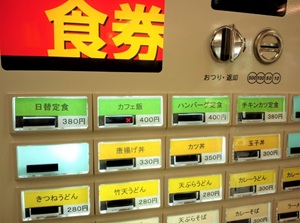
Ticket vending machine in a busy restaurant
There is no waiter, waitress, or staff in small ramen restaurants, and fast food restaurant such as Gyudon, etc.
Because the chefs are busy, the restaurant sets up a ticket vending machine for the order at the entrance.
You buy a ticket of the dish you want to order and give the chef the ticket.
The chef makes the dish by the ticket.
In most cases, the vending machine accepts only cash.
You should prepare cash in Japan.

